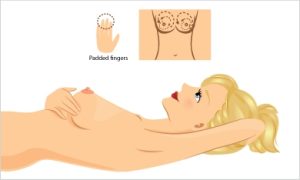Breast Self-Examination: A Small Step, A Big Protection
The Breast self-examination is a simple, quick, and invaluable preventive practice. A woman who is familiar with the normal anatomy and physiology of her body is more likely to detect early changes that may indicate an underlying pathology. Early detection saves lives — and self-examination is the first step in proactive breast health monitoring.

Why is breast self-examination important?
The Breast cancer is the most common cancer in women, affecting approximately 1 in 8 women during their lifetime. Although it does not replace the clinical examination or the mammography, monthly self-examination can help in the detection of early signs that require medical evaluation.
Approximately 40% of breast cancer cases are initially detected by women themselves through breast self-examination.
What signs and symptoms can be observed?
During breast self-examination, look for the following warning signs:
- A new mass or palpable induration
- Change in the shape, size, or symmetry of the breast
- Skin dimpling, thickening, or wrinkling
- Erythema, inflammation, or rash
- Nipple retraction or discharge (especially if bloody)
- Persistent pain unrelated to the menstrual cycle
Note: 8 out of 10 breast masses are benign but always require evaluation by a breast surgeon.

How to perform breast self-examination correctly
The breast self-examination takes less than 10 minutes and is performed in 3 steps:
- In front of the mirror
Observe the breasts with your hands
- At your sides
- Raised above your head
- With shoulders relaxed and arms at your sides
Check for changes in symmetry, shape, or color
- In the shower
With the fingers flat and together, use circular motions from the periphery of the breast toward the nipple. Also palpate the axilla, where lymph nodes are located.
- Lying down in bed
With one arm positioned behind your head, examine the opposite breast using the same circular motions.

When is the appropriate time?
If menstruating:: Perform the examination between days 7 and 15 of your menstrual cycle, when breast tissue is less tender.
If postmenopausal:: Choose a consistent day each month (e.g., the 1st).
Breast self-examination as part of a comprehensive prevention strategy
For effective prevention, combine self-examination with:
- Annual clinical breast examination by a healthcare professional
- Mammography starting at age 40, or earlier if there is a family history
- Education and awareness about risk factors and symptoms
If you notice anything unusual, do not panic — but do not ignore it
The Timely evaluation by a specialist is crucial. While many changes are benign, early investigation ensures accurate diagnosis and appropriate intervention when necessary.
Remember:
The power of prevention is literally in your hands. Incorporate breast self-examination into your personal health routine and stay vigilant about your breast health.
breastaware.gr — Your reliable guide for breast cancer prevention, early detection, and care.
Learn, examine, prevent.
Sources:
- Bray F, Ferlay J, Soerjomataram I, Siegel RL, Torre LA, Jemal A. Global cancer statistics 2020: GLOBOCAN estimates of incidence and mortality worldwide. CA Cancer J Clin. 2020;70(4):313–331.
- American Cancer Society. Breast cancer facts & figures 2022-2023.
- Berg WA, Blume JD, Cormack JB, et al. Operator dependency of physician-performed whole-breast US: lesion detection and characterization. Radiology. 2006;241(2):355–365.
